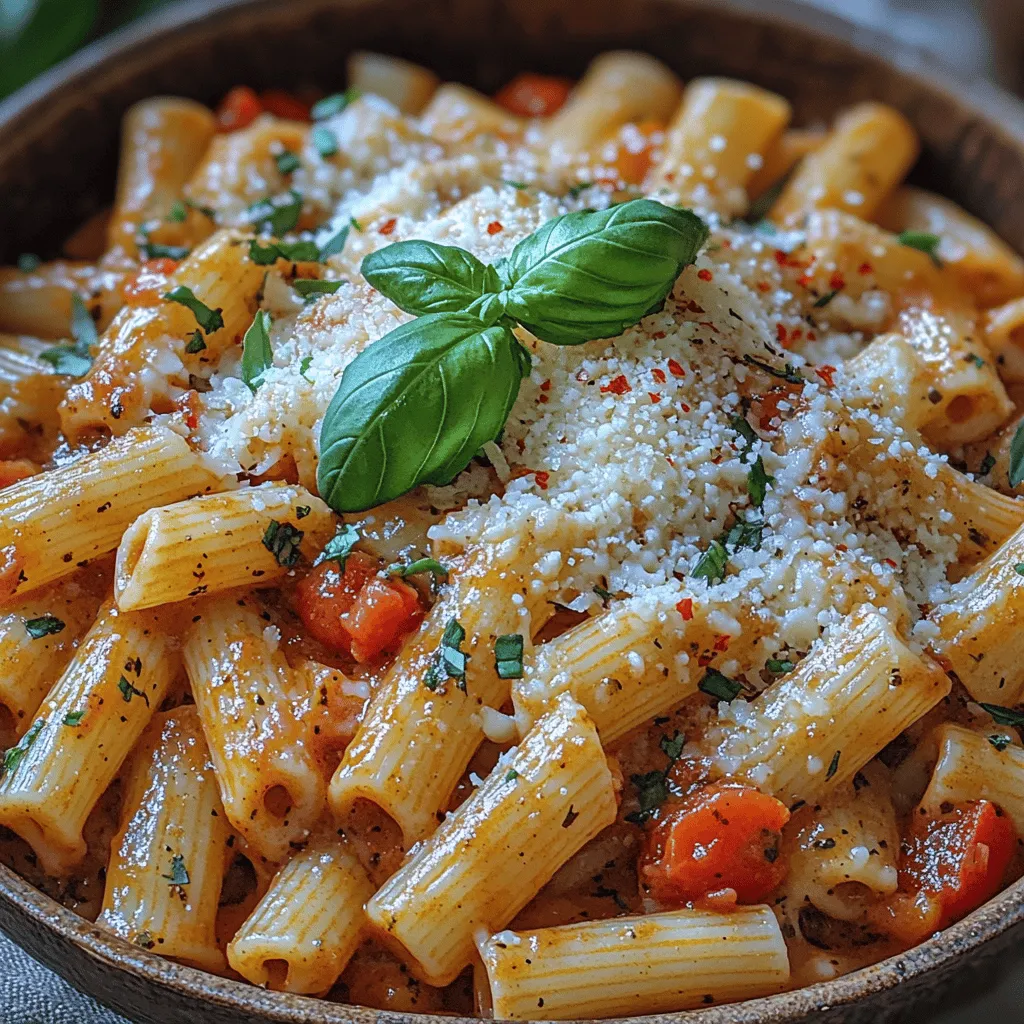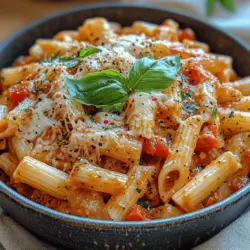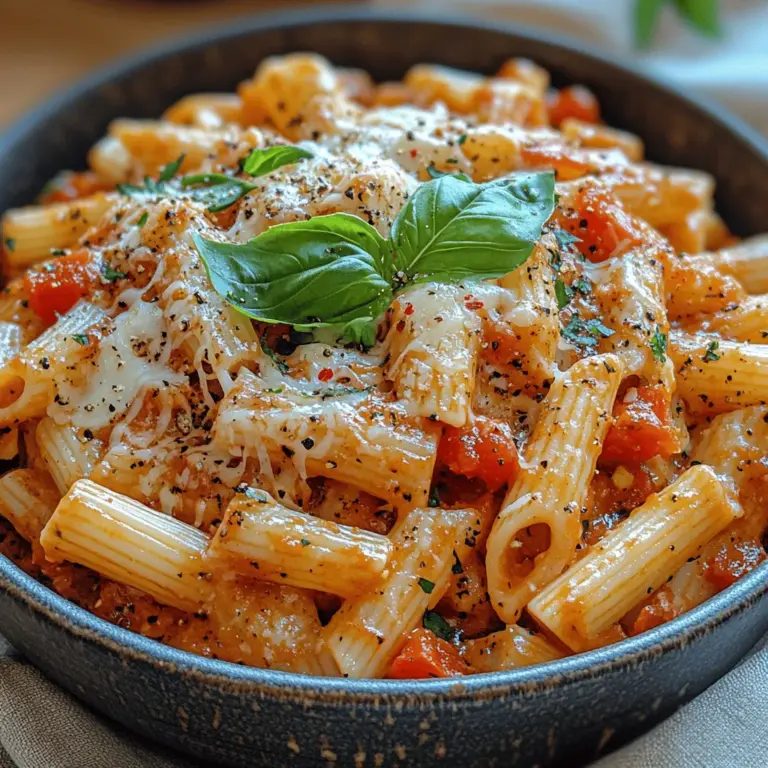Slow-Cooked Tomato Basil Pasta: A Comforting Delight for Busy Schedules
In today’s fast-paced world, finding time to prepare a wholesome meal can often feel like a daunting task. Enter Slow-Cooked Tomato Basil Pasta — a deliciously comforting dish that brings together the rich flavors of ripe tomatoes, aromatic basil, and wholesome pasta, all while fitting seamlessly into your busy lifestyle. This recipe celebrates the art of slow cooking, allowing flavors to meld beautifully over hours, resulting in a dish that is both satisfying and nourishing. Whether you’re a busy professional, a parent juggling multiple responsibilities, or simply someone who appreciates a hearty meal without the fuss, this slow-cooked pasta dish is sure to become a staple in your kitchen.
Slow cooking is much more than just a cooking method; it’s a way to enhance the natural flavors of your ingredients. When you allow ingredients to simmer gently over time, they release their essence, creating a depth of flavor that’s hard to achieve with quick cooking methods. With minimal effort, you can prepare a meal that tastes like it has been simmering on the stove all day long. Moreover, slow cooking means you can set it and forget it; simply assemble your ingredients, set your slow cooker, and go about your day while it does all the hard work for you.
One of the many appealing aspects of this Slow-Cooked Tomato Basil Pasta is its versatility. Not only is it a wonderful option for vegetarians, but it can also be customized to suit various dietary preferences. If you enjoy creamy pasta dishes, you can easily add a splash of cream or a dollop of ricotta cheese before serving. This adaptability makes it perfect for family dinners or gatherings, where everyone’s tastes can be catered to.
Understanding the Ingredients
To create a truly delectable Slow-Cooked Tomato Basil Pasta, it’s essential to understand the role of each ingredient in the recipe. Each component contributes to the dish’s overall flavor, texture, and nutritional profile.
Penne Pasta: The base of this dish is penne pasta, which is not only satisfying but also ideal for soaking up the delicious sauce. Its tubular shape allows it to capture the slow-cooked tomato and basil sauce, ensuring that every bite is packed with flavor.
Diced Tomatoes: At the heart of this recipe lies diced tomatoes — they provide the essential moisture and form the base of the sauce. Their natural sweetness pairs beautifully with the savory elements, creating a rich and flavorful sauce that enhances the pasta.
Onion and Garlic: Aromatics like onion and garlic are fundamental in any great dish. They add layers of flavor that elevate the overall taste profile. When slow-cooked, these ingredients caramelize, bringing out their natural sweetness and adding depth to the sauce.
Vegetable Broth: To achieve the perfect sauce consistency and depth of flavor, vegetable broth is incorporated. This not only enriches the overall taste but also ensures that the pasta cooks evenly, absorbing all the delicious flavors.
Olive Oil, Oregano, and Basil: For that quintessential Italian flavor, olive oil, oregano, and fresh basil are crucial. Olive oil provides richness, while oregano adds an earthy note. Fresh basil, added towards the end of cooking, brightens the dish with its aromatic freshness.
Optional Red Pepper Flakes: If you prefer a little kick, consider adding red pepper flakes. They give the dish a subtle heat that can elevate the flavor profile without overwhelming the palate.
In addition to the delicious flavors they bring, the ingredients in this pasta dish also offer nutritional benefits. Whole grain penne pasta is a great source of fiber, contributing to digestive health and providing a feeling of fullness. Tomatoes are packed with antioxidants, particularly lycopene, which is known for its health benefits. Combined, these ingredients create a meal that is not only tasty but also beneficial for your well-being.
Preparation Steps
The key to a successful Slow-Cooked Tomato Basil Pasta lies in the preparation. Before you dive into cooking, it’s essential to prepare your ingredients in advance. This ensures a smooth cooking process and allows the flavors to develop harmoniously.
1. Chop Your Aromatics: Start by finely chopping your onion and mincing the garlic. The smaller the pieces, the more readily they will release their flavors during the slow cooking process.
2. Measure Out Your Ingredients: Take the time to measure out your diced tomatoes, vegetable broth, and any seasonings you plan to use. This step is crucial, as it allows you to have everything ready to go when you begin layering in the slow cooker.
3. Layering in the Crockpot: The order in which you layer your ingredients in the slow cooker is vital for even cooking. Begin with a layer of diced tomatoes at the bottom, which will help prevent the pasta from sticking to the bottom of the pot. Follow this with your chopped onions and minced garlic, then sprinkle in the oregano and red pepper flakes if desired. Next, add the uncooked penne pasta, ensuring it’s evenly distributed. Pour in the vegetable broth and drizzle with olive oil. Finally, top with fresh basil, reserving some for garnish when serving.
4. Understanding Layering: Layering is critical for achieving optimal results in slow cooking. By placing the liquid ingredients at the bottom, you create a steamy environment that allows the pasta to cook evenly, absorbing all the delicious flavors from the sauce. This method prevents any ingredients from burning or sticking, resulting in a perfectly cooked dish.
By following these preparation steps, you’re setting yourself up for a delightful cooking experience. The anticipation builds as you allow your Slow-Cooked Tomato Basil Pasta to simmer, filling your kitchen with mouthwatering aromas. This initial phase of preparation is just the beginning of what will soon become a comforting and flavorful meal, perfect for enjoying with family or friends.

Adding the Pasta
Once your tomato basil sauce has simmered and the flavors have melded beautifully, it’s time to introduce the star of the dish: the pasta. Choose a pasta that holds up well in a slow cooker, such as penne, rigatoni, or fusilli. These shapes will capture the sauce and offer a delightful bite.
Tips on Ensuring the Pasta is Fully Submerged for Optimal Cooking
For even cooking, it is crucial that the pasta is fully submerged in the sauce. If the pasta is not adequately covered, it may cook unevenly, resulting in some strands being overcooked while others remain undercooked. To ensure this, gently stir the pasta into the sauce, ensuring that each piece is surrounded by that rich, flavorful liquid. If necessary, add a bit more water or broth to cover the pasta completely. This will help achieve that perfect al dente texture, where the pasta is firm to the bite but not hard.
Cooking Times and Methods
The cooking time for your slow-cooked tomato basil pasta will depend on the setting you choose. Generally, cooking on low heat will take about 4 to 5 hours, while the high setting may reduce the time to approximately 2 to 3 hours. It’s essential to monitor the pasta as it cooks.
Differences Between Low and High Settings, Including Tips for Monitoring Progress
Using the low setting allows for a slow infusion of flavors, producing a more robust sauce. However, if you’re short on time, the high setting can still yield delicious results. Regardless of the setting, check for doneness about 30 minutes before the recommended cooking time. Stir the pasta gently to prevent clumping and to ensure even cooking. If it seems too dry, add a splash of water or broth to keep it saucy.
Transforming the Dish
To elevate your slow-cooked tomato basil pasta, consider incorporating heavy cream. This addition transforms the dish into a rich, creamy delight that adds depth to the tomato base.
Exploring the Option of Adding Heavy Cream
Heavy cream not only enhances the flavor but also changes the texture, making it more luxurious. If you opt for this addition, stir in about 1 cup of heavy cream during the last 30 minutes of cooking. This timing allows the cream to meld with the sauce without breaking down.
How Cream Changes the Dish’s Texture and Flavor Profile
The inclusion of cream will soften the acidity of the tomatoes, resulting in a balanced flavor profile that is both comforting and indulgent. The sauce becomes velvety, and the richness complements the basil beautifully, creating a harmonious blend.
Suggestions for Alternative Creamy Ingredients
For those seeking a dairy-free option, consider using cashew cream or coconut cream. To make cashew cream, soak raw cashews in water for a few hours, then blend with a bit of water until smooth. Stir this cream into your pasta to achieve that desired richness without dairy.
Enhancing Flavors with Fresh Herbs
Fresh herbs play a vital role in enhancing the overall flavor of your dish. While basil is the star of this recipe, consider adding other herbs like oregano or thyme for added complexity. Fresh herbs should be added toward the end of the cooking process to preserve their flavor.
The Role of Fresh Basil in Elevating the Final Dish
Basil should be used generously, both during cooking and as a garnish. It not only adds a fresh, aromatic quality but also brightens the overall dish. Toss in a handful of torn basil leaves just before serving for an aromatic finish that will impress your guests.
Suggestions for Other Herbs That Can Complement the Recipe
Other herbs that complement the tomato and basil flavor profile include parsley for freshness, rosemary for earthiness, or even a hint of crushed red pepper for a spicy kick. Experimenting with these herbs can lead to delightful variations that keep the dish exciting every time you prepare it.
Serving Suggestions
Presentation can elevate any dish, and your slow-cooked tomato basil pasta is no exception.
Presentation Ideas for Serving
When serving, consider using shallow bowls for a cozy, rustic feel or wide plates for a more elegant presentation. Regardless of your choice, ensure that the dish is garnished attractively. A sprinkle of freshly grated Parmesan cheese on top, along with a few basil leaves, can transform the look of the dish.
Using Bowls vs. Plates, Garnishing with Fresh Basil and Parmesan
If using bowls, serve the pasta first and then add a generous drizzle of olive oil on top before garnishing with basil and cheese. For plates, twirl the pasta into a nest shape and top it with sauce, then finish with the same garnishes. This attention to detail makes a simple dish feel gourmet.
Suggested Pairings
Pair your pasta with a fresh green salad dressed in a light vinaigrette. The acidity of the dressing will balance the richness of the pasta. Garlic bread is another classic pairing, providing a crunchy contrast to the tender pasta.
Recommended Sides or Salads That Complement the Pasta Dish
Consider serving a side of roasted vegetables or a Caprese salad for additional freshness and color on the plate. These sides will enhance the meal while offering a delightful variety of textures and flavors.
Suitable Beverages to Enhance the Dining Experience
For beverage pairings, a crisp white wine, such as Sauvignon Blanc or Pinot Grigio, complements the tomato-based dish beautifully. If you prefer non-alcoholic options, a sparkling water with a splash of lemon or a homemade lemonade would refresh the palate.
Conclusion
In summary, this slow-cooked tomato basil pasta is a delightful blend of simplicity, flavor, and comfort. The slow cooking process allows the ingredients to meld beautifully, resulting in a dish that is both satisfying and aromatic. With the option to transform it into a creamy delight or keep it light and fresh, this recipe invites experimentation and personalization.
The joy of slow cooking lies in the anticipation, the aroma wafting through your home, and the ultimate satisfaction of enjoying a homemade meal. Don’t hesitate to make this dish your own by trying different herbs, creamy additions, or side dishes. Each variation offers a new experience, ensuring that this recipe will become a staple in your culinary repertoire. Enjoy the journey of cooking and the delicious results that come from it!

